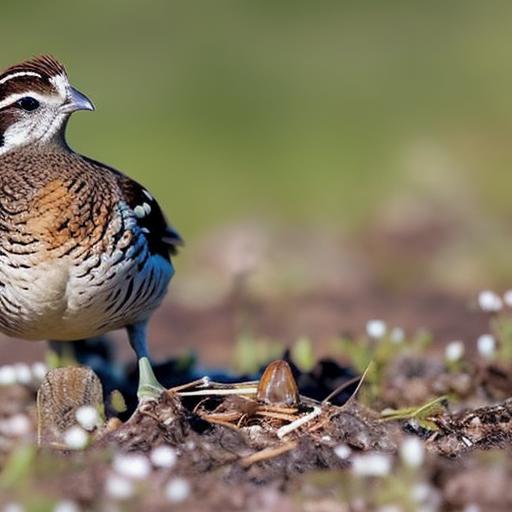When setting up a brooder for your chicks, it’s important to consider the size and materials of the brooder. The brooder should be large enough to accommodate the number of chicks you have, allowing each chick at least 1 square foot of space. This will prevent overcrowding and ensure that the chicks have enough room to move around and exercise. The brooder can be made from a variety of materials, including cardboard, wood, or plastic. It should have a solid bottom to prevent drafts and provide a secure environment for the chicks.
In addition to the size and materials of the brooder, it’s important to consider the bedding and heating elements. The bedding should be absorbent and easy to clean, such as pine shavings or straw. Avoid using cedar shavings, as they can be toxic to chicks. The brooder should also be equipped with a heat source, such as a heat lamp or heating pad, to maintain a temperature of around 95 degrees Fahrenheit for the first week of the chicks’ lives. The temperature can then be gradually reduced by 5 degrees each week until the chicks are fully feathered and can regulate their own body temperature. Finally, the brooder should have a secure lid or cover to prevent the chicks from escaping and to protect them from predators. By carefully considering the size, materials, bedding, heating elements, and security of the brooder, you can create a safe and comfortable environment for your chicks to thrive in.
When it comes to setting up a brooder for your chicks, there are several key factors to consider. First and foremost, the brooder should be spacious enough to accommodate the number of chicks you have, allowing each chick enough room to move around and exercise. This will help prevent overcrowding and ensure that the chicks are comfortable and healthy. Additionally, the brooder should be made from a sturdy and secure material, such as wood or plastic, with a solid bottom to prevent drafts and provide a safe environment for the chicks. The bedding in the brooder should be absorbent and easy to clean, such as pine shavings or straw, and a heat source, such as a heat lamp or heating pad, should be provided to maintain a temperature of around 95 degrees Fahrenheit for the first week of the chicks’ lives. Finally, the brooder should have a secure lid or cover to prevent the chicks from escaping and protect them from predators. By carefully considering these factors when setting up your brooder, you can create a comfortable and safe environment for your chicks to grow and thrive in.
Key Takeaways
- Setting up the brooder:
- Choose a draft-free location with enough space for the chicks to move around.
- Use a heat lamp to maintain a temperature of 95-100°F for the first week, then decrease by 5°F each week.
- Provide a non-slippery surface and bedding for the chicks to walk on.
- Feeding and watering:
- Use chick starter feed with at least 18% protein.
- Provide clean water at all times, using a shallow dish or special chick waterer.
- Avoid overfeeding and monitor for signs of dehydration or malnutrition.
- Temperature and lighting:
- Monitor the temperature regularly and adjust the heat lamp as needed.
- Provide 14-16 hours of light per day to encourage healthy growth and development.
- Handling and socialization:
- Handle the chicks gently and frequently to promote socialization and reduce fear of humans.
- Introduce new objects and experiences to the chicks to help them adapt to their environment.
- Health and hygiene:
- Keep the brooder clean and dry to prevent the spread of diseases.
- Watch for signs of illness, such as lethargy or abnormal droppings, and seek veterinary care if necessary.
- Transitioning to outdoor housing:
- Gradually introduce the chicks to outdoor temperatures and conditions.
- Provide a secure outdoor coop with access to food, water, and protection from predators.
- Monitoring growth and development:
- Keep track of the chicks’ weight and overall development.
- Watch for signs of feather growth and behavior changes as the chicks mature.
Feeding and watering
Feeding and watering your chicks is an essential part of raising healthy and happy chickens. When it comes to feeding, it’s important to provide your chicks with a high-quality chick starter feed that is specifically formulated for their nutritional needs. This feed should contain essential nutrients such as protein, vitamins, and minerals to support healthy growth and development. It’s also important to ensure that the feed is fresh and free from mold or contaminants. Additionally, you can supplement their diet with treats such as fruits, vegetables, and mealworms to provide variety and additional nutrients.
In addition to feeding, providing clean and fresh water is crucial for your chicks’ health and well-being. Chicks can quickly become dehydrated, so it’s important to check their water supply regularly and ensure that it is free from contaminants. Using a shallow water dish or specialized chick waterer can help prevent spills and keep the water clean. It’s also important to monitor the temperature of the water, as chicks prefer slightly warm water. By providing high-quality feed, fresh water, and occasional treats, you can ensure that your chicks are well-nourished and thriving.
Feeding and watering your chicks is an essential part of raising healthy and happy chickens. When it comes to feeding, it’s important to provide your chicks with a high-quality chick starter feed that is specifically formulated for their nutritional needs. This feed should contain essential nutrients such as protein, vitamins, and minerals to support healthy growth and development. It’s also important to ensure that the feed is fresh and free from mold or contaminants. Additionally, you can supplement their diet with treats such as fruits, vegetables, and mealworms to provide variety and additional nutrients.
In addition to feeding, providing clean and fresh water is crucial for your chicks’ health and well-being. Chicks can quickly become dehydrated, so it’s important to check their water supply regularly and ensure that it is free from contaminants. Using a shallow water dish or specialized chick waterer can help prevent spills and keep the water clean. It’s also important to monitor the temperature of the water, as chicks prefer slightly warm water. By providing high-quality feed, fresh water, and occasional treats, you can ensure that your chicks are well-nourished and thriving.
Temperature and lighting
Maintaining the right temperature and lighting in the brooder is crucial for the health and well-being of your chicks. For the first week of their lives, chicks require a temperature of around 95 degrees Fahrenheit. This can be achieved using a heat lamp or heating pad placed at one end of the brooder, allowing the chicks to move away from the heat source if they become too warm. As the chicks grow and develop feathers, the temperature can be gradually reduced by 5 degrees each week until they are fully feathered and able to regulate their own body temperature.
In addition to maintaining the right temperature, providing appropriate lighting is also important for your chicks’ development. A regular day-night cycle with 14-16 hours of light per day is ideal for young chicks. This can be achieved using a simple light bulb or specialized chick brooder light. Providing consistent lighting will help regulate their circadian rhythms and promote healthy growth. By carefully monitoring and adjusting the temperature and lighting in the brooder, you can create an optimal environment for your chicks to thrive in.
Maintaining the right temperature and lighting in the brooder is crucial for the health and well-being of your chicks. For the first week of their lives, chicks require a temperature of around 95 degrees Fahrenheit. This can be achieved using a heat lamp or heating pad placed at one end of the brooder, allowing the chicks to move away from the heat source if they become too warm. As the chicks grow and develop feathers, the temperature can be gradually reduced by 5 degrees each week until they are fully feathered and able to regulate their own body temperature.
In addition to maintaining the right temperature, providing appropriate lighting is also important for your chicks’ development. A regular day-night cycle with 14-16 hours of light per day is ideal for young chicks. This can be achieved using a simple light bulb or specialized chick brooder light. Providing consistent lighting will help regulate their circadian rhythms and promote healthy growth. By carefully monitoring and adjusting the temperature and lighting in the brooder, you can create an optimal environment for your chicks to thrive in.
Handling and socialization
Handling and socializing your chicks from a young age is important for their development and future behavior as adult chickens. Gentle handling can help them become more comfortable around humans and reduce fearfulness. When handling your chicks, it’s important to approach them calmly and avoid sudden movements or loud noises that could startle them. Gently scoop them up from underneath with both hands, supporting their body weight, and hold them close to your body to provide warmth and security.
In addition to handling, providing opportunities for socialization with other chicks is important for their well-being. Chicks are social animals that thrive in groups, so it’s important to raise them together whenever possible. This will help them learn important social behaviors such as pecking order and communication. Providing toys such as mirrors or hanging treats can also encourage social interaction among the chicks. By gently handling and providing opportunities for socialization, you can help your chicks develop into confident and well-adjusted adult chickens.
Handling and socializing your chicks from a young age is important for their development and future behavior as adult chickens. Gentle handling can help them become more comfortable around humans and reduce fearfulness. When handling your chicks, it’s important to approach them calmly and avoid sudden movements or loud noises that could startle them. Gently scoop them up from underneath with both hands, supporting their body weight, and hold them close to your body to provide warmth and security.
In addition to handling, providing opportunities for socialization with other chicks is important for their well-being. Chicks are social animals that thrive in groups, so it’s important to raise them together whenever possible. This will help them learn important social behaviors such as pecking order and communication. Providing toys such as mirrors or hanging treats can also encourage social interaction among the chicks. By gently handling and providing opportunities for socialization, you can help your chicks develop into confident and well-adjusted adult chickens.
Health and hygiene
Maintaining good health and hygiene practices is essential for keeping your chicks happy and disease-free. Regularly cleaning the brooder by removing soiled bedding and replacing it with fresh bedding will help prevent bacterial growth and keep the environment clean. It’s also important to monitor your chicks for any signs of illness or distress, such as lethargy, loss of appetite, or abnormal droppings.
In addition to cleanliness, providing proper nutrition is crucial for maintaining good health in your chicks. A high-quality chick starter feed that is specifically formulated for their nutritional needs will provide essential nutrients for healthy growth and development. Additionally, providing clean water at all times will help prevent dehydration.
Finally, it’s important to practice good biosecurity measures to prevent the spread of disease. This includes limiting contact with other birds or animals, washing hands before and after handling your chicks, and disinfecting any equipment or supplies that come into contact with them. By maintaining good health and hygiene practices, you can help ensure that your chicks grow into healthy adult chickens.
Maintaining good health and hygiene practices is essential for keeping your chicks happy and disease-free. Regularly cleaning the brooder by removing soiled bedding and replacing it with fresh bedding will help prevent bacterial growth and keep the environment clean. It’s also important to monitor your chicks for any signs of illness or distress, such as lethargy, loss of appetite, or abnormal droppings.
In addition to cleanliness, providing proper nutrition is crucial for maintaining good health in your chicks. A high-quality chick starter feed that is specifically formulated for their nutritional needs will provide essential nutrients for healthy growth and development. Additionally, providing clean water at all times will help prevent dehydration.
Finally, it’s important to practice good biosecurity measures to prevent the spread of disease. This includes limiting contact with other birds or animals, washing hands before and after handling your chicks, and disinfecting any equipment or supplies that come into contact with them. By maintaining good health and hygiene practices, you can help ensure that your chicks grow into healthy adult chickens.
Transitioning to outdoor housing

As your chicks grow older and develop feathers, they will eventually outgrow their brooder and need to transition to outdoor housing. Before making this transition, it’s important to gradually acclimate them to outdoor temperatures by taking them outside for short periods of time during mild weather conditions.
When transitioning your chicks to outdoor housing, it’s important to provide a secure coop or chicken run that offers protection from predators such as foxes or hawks. The coop should also have adequate ventilation to prevent moisture buildup and maintain good air quality.
In addition to providing a secure outdoor housing environment, it’s important to gradually introduce your chicks to free-ranging if desired. Allowing them access to a fenced-in area with grass or vegetation will provide opportunities for exercise, natural foraging behavior, and exposure to sunlight.
By carefully transitioning your chicks to outdoor housing with gradual acclimation periods and providing a secure coop or chicken run with access to free-ranging opportunities, you can ensure that they continue to thrive in their new environment.
As your chicks grow older and develop feathers, they will eventually outgrow their brooder and need to transition to outdoor housing. Before making this transition, it’s important to gradually acclimate them to outdoor temperatures by taking them outside for short periods of time during mild weather conditions.
When transitioning your chicks to outdoor housing, it’s important to provide a secure coop or chicken run that offers protection from predators such as foxes or hawks. The coop should also have adequate ventilation to prevent moisture buildup and maintain good air quality.
In addition to providing a secure outdoor housing environment, it’s important to gradually introduce your chicks to free-ranging if desired. Allowing them access to a fenced-in area with grass or vegetation will provide opportunities for exercise, natural foraging behavior, and exposure to sunlight.
By carefully transitioning your chicks to outdoor housing with gradual acclimation periods and providing a secure coop or chicken run with access to free-ranging opportunities, you can ensure that they continue to thrive in their new environment.
Monitoring growth and development
Monitoring the growth and development of your chicks is essential for ensuring that they are healthy and thriving as they mature into adult chickens. Keep track of their weight gain by regularly weighing them using a small scale designed for poultry.
In addition to weight gain, observe their behavior and overall appearance for any signs of illness or distress. Healthy chickens should be active with bright eyes, clean feathers, smooth movement without limping or abnormal posture.
As they mature into adult chickens, monitor their egg production (if raising hens) or overall health if raising chickens for meat or companionship.
By closely monitoring their growth through weight gain tracking along with observing behavior changes over time will help ensure that they are developing properly into healthy adult chickens.
Monitoring the growth and development of your chicks is essential for ensuring that they are healthy and thriving as they mature into adult chickens. Keep track of their weight gain by regularly weighing them using a small scale designed for poultry.
In addition to weight gain tracking observe their behavior changes over time along with overall appearance for any signs of illness or distress such as lethargy or loss of appetite.
As they mature into adult chickens monitor their egg production (if raising hens) or overall health if raising chickens for meat or companionship.
By closely monitoring their growth through weight gain tracking along with observing behavior changes over time will help ensure that they are developing properly into healthy adult chickens.
By closely monitoring their growth through weight gain tracking along with observing behavior changes over time, chicken owners can ensure that they are developing properly into healthy adult chickens. Regularly weighing the chickens and keeping records of their weight gain can provide valuable insight into their overall health and development. Additionally, observing their behavior for any signs of illness or distress can help identify any potential issues early on. This proactive approach to monitoring their growth and behavior will contribute to raising strong and healthy adult chickens.
If you’re looking for tips on how to keep quail chicks, you might also be interested in learning about the best chicken coop options for raising poultry. Check out this informative article on 10 Essential Features of a Chicken Coop to ensure that your quail chicks have a safe and comfortable environment to thrive in.
FAQs
What do quail chicks eat?
Quail chicks should be fed a high-protein game bird starter feed, which can be found at most feed stores. This feed provides the essential nutrients and protein that quail chicks need for healthy growth.
How do you keep quail chicks warm?
Quail chicks need to be kept in a warm environment, ideally around 95-100 degrees Fahrenheit for the first week of their lives. This can be achieved using a heat lamp or a brooder.
How do you provide water for quail chicks?
Quail chicks should have access to clean, fresh water at all times. It is important to use a shallow waterer to prevent the chicks from drowning, and to keep the water clean to prevent disease.
How do you handle quail chicks?
When handling quail chicks, it is important to be gentle and to support their bodies. Avoid picking them up by their wings or legs, and be sure to wash your hands before and after handling them to prevent the spread of disease.
How do you protect quail chicks from predators?
Quail chicks are vulnerable to predators, so it is important to provide them with a secure enclosure. This can include a wire mesh or netting to prevent access from predators such as cats, dogs, and birds of prey.
Meet Walter, the feathered-friend fanatic of Florida! Nestled in the sunshine state, Walter struts through life with his feathered companions, clucking his way to happiness. With a coop that’s fancier than a five-star hotel, he’s the Don Juan of the chicken world. When he’s not teaching his hens to do the cha-cha, you’ll find him in a heated debate with his prized rooster, Sir Clucks-a-Lot. Walter’s poultry passion is no yolk; he’s the sunny-side-up guy you never knew you needed in your flock of friends!







